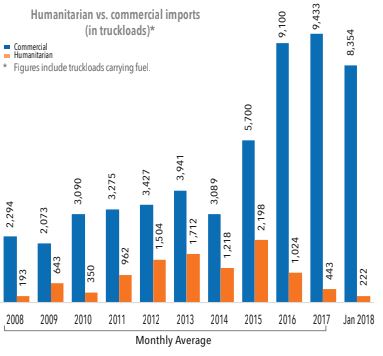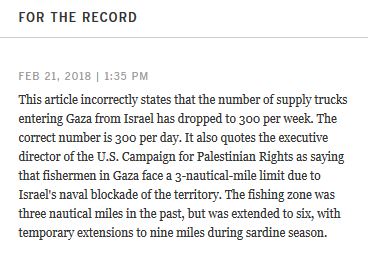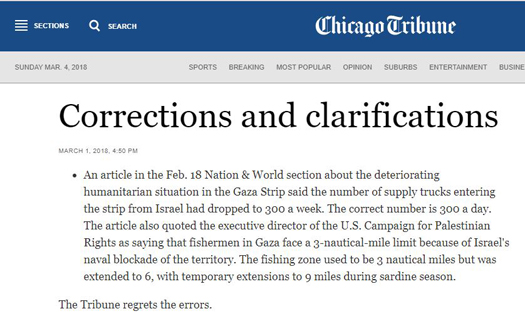CAMERA’s Israel office last week prompted a series of corrections in The Los Angeles Times. As noted earlier this month in CAMERA’s Snapshots blog, a Feb. 7 article by Noga Tarnopolsky and Rushdi Abu Alouf (“Neither Israel nor Hamas wants another war in Gaza. That might not be enough to stop one“) wrongly reported: “Egypt’s border with Gaza is closed and Israel allows only trucks carrying food or other humanitarian necessities in and out.”
Israel allows commercial goods in and out of the Gaza Strip – not just food and humanitarian goods. In fact, according to the United Nations’ Office for the Coordination of Humanitarian Affairs Gaza Crossings’ Operation Status: Monthly Update (January 2018), that month 8,354 truckloads of commercial goods entered the Gaza Strip, versus 222 truckloads of humanitarian goods. Israel allows all goods, commercial and humanitarian, in the Gaza Strip, aside from those it considers dual use (for military and civilian purposes.)

The Times has yet to correct the false claim that Israel allows only food and humanitarian items through the Gaza crossing. Yet, after CAMERA sent editors data for the number of trucks crossing in January and December (over 10,000), editors did commendably correct figures in the same article which grossly understated the amount of trucks.
In addition to misreporting the type of goods permitted to enter, Tarnopolsky and Abu Alouf had misreported the quantity, stating:
In what the Israeli army is calling an indication of the dramatic drop in Gazans’ purchasing power, the number of supply trucks entering the strip weekly from Israel has recently gone from an average of 900 to about 300.
In fact, as indicated by the U.N’s data, over 2000 trucks per week cross into the Gaza Strip, not 300.
Editors commendably added the correction to the top right side of the digital article:
This article incorrectly says the number of supply trucks entering the Gaza Strip from Israel has gone from 900 to 300 weekly. The figures are for daily crossings.
Los Angeles Times’ unusual policy is to add the correction to the digital article, while at the same time leaving the original error uncorrected.
In addition, the identical error appeared the very next day in another Times article about Gaza, this one by Ann M. Simmons with reporting by Noga Tarnopolsky (“Life in the Strip — a cauldron of deficit, despair and desperation,” Feb. 8).
That article had erred:
The dramatic drop in purchasing power of Gazans is evident in the number of supply trucks entering the strip weekly from Israel. It has dropped from an average of 900 trucks a week to about 300, according to Israeli army data.
Moreover, Simmons’ article carried an additional error, citing without challenge or correction erroneous information provided by Yousef Munayyer of the U.S. Campaign for Palestinian Rights. It states:
The fishing industry has been central to Gaza for hundreds of years because of the region’s proximity to the coast, but fishermen are not permitted to go beyond three nautical miles because of a naval blockade, he said.“So now in recent years, for the first time in history, the primary source of fish in the Gaza Strip is no longer fresh cod fish, but farmed fish on land, because there’s an overfishing problem within the 3-nautical-mile limit,” Munayyer said. “Many of the species the fishermen go after is beyond that mark now.”
Regarding Gaza’s current fishing zone, CAMERA checked with Israel’s Office of the Coordinator of Government Activities in the Territories (COGAT), and received the following response:
In the routine, the fishing zone is six nautical miles.In addition, during the fishing seasons between October – December and April-June, the fishing zone was increased to nine nautical miles.Only in the last fishing season did fish yield grow by 200% and fish prices fell by about 25%.Despite the existence of civilian measures to prevent civil deterioration in the Gaza Strip, there are security deviations that affect only fishermen themselves.
CAMERA relayed COGAT’s response to The Times. As a result of CAMERA’s communication with The Times, editors thanked CAMERA for bringing the Gaza crossing and fishing zone errors to their attention. On Feb.21, editors commendably added the following multi-part correction to the online article:
This article incorrectly states that the number of supply trucks entering Gaza from Israel has dropped to 300 per week. The correct number is 300 per day. It also quotes the executive director of the U.S. Campaign for Palestinian Rights as saying that fishermen in Gaza face a 3-nautical-mile limit due to Israel’s naval blockade of the territory. The fishing zone was three nautical miles in the past, but was extended to six, with temporary extensions to nine miles during sardine season.

In addition, the correction appeared in the print edition on Feb. 22. Simmons’ article appeared in The Chicago Tribune on Feb. 18, and CAMERA has contacted editors there as well to request corrections. Stay tuned for an update.
For additional Los Angeles Times corrections prompted by CAMERA, please see here.
March 4 Update: CAMERA Prompts Chicago Tribune Corrections
On March 2, The Chicago Tribune commendably published the following correction in print, and it also appeared online here March 1:

